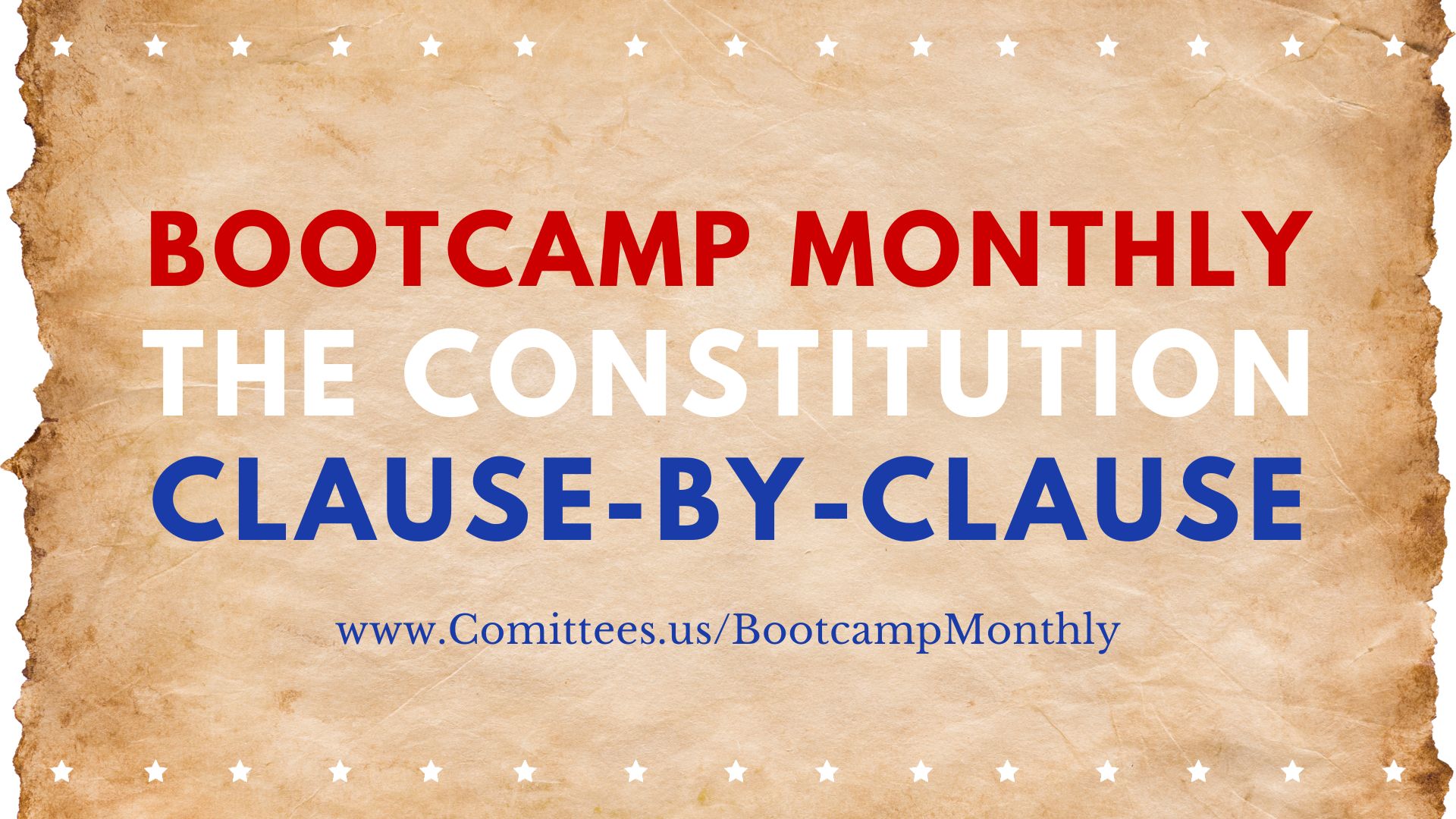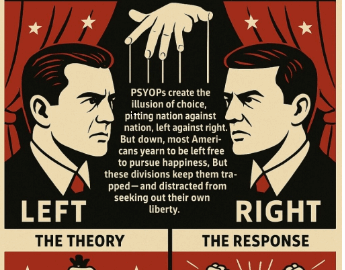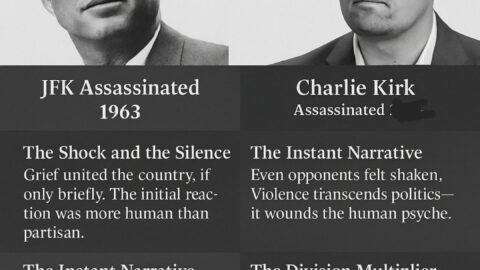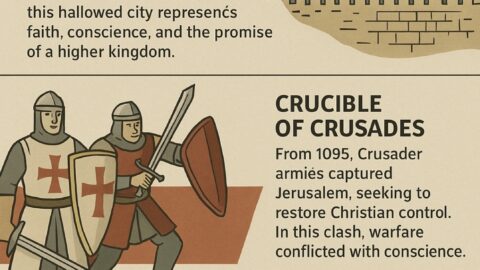A moral stress test
The monologue opens with a shock: a political figure is murdered while speaking to students. Chase Hughes’s central alarm isn’t only the killing—it’s the online reaction.
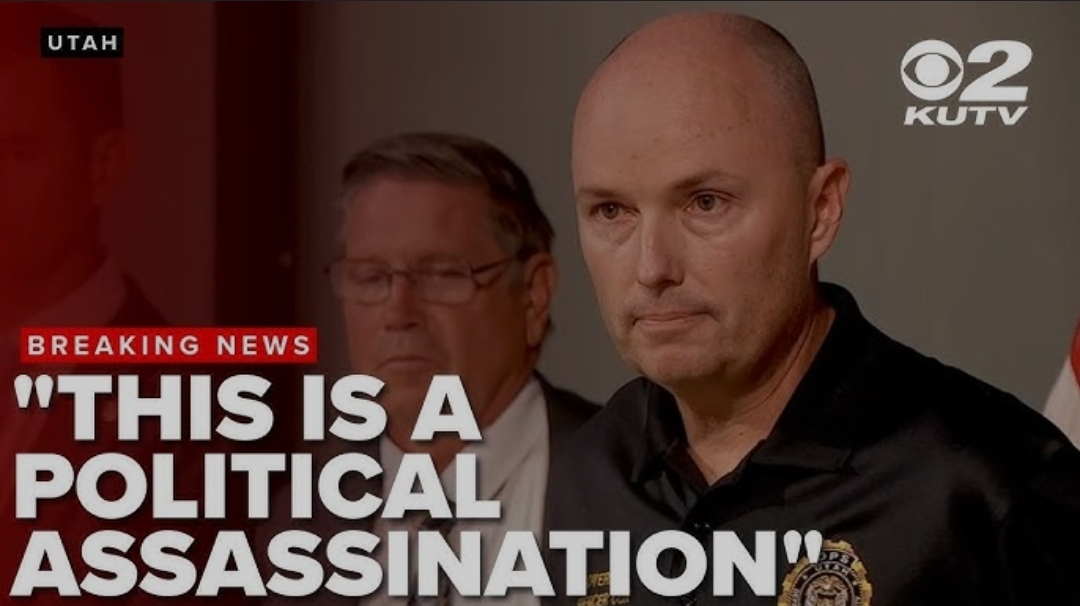
Instead of near-universal revulsion, he sees gleeful memes, celebratory comments, and performative cruelty. That response, he argues, is a moral mask slipping. When a political assassination becomes “just another headline” we scroll past—or worse, a moment for tribal cheers—something deep has broken.
Doomscrolling the reaction, not the news. After the shooting, Hughes admits he stayed up late on X, “marinating in the hate”—he even likens the pull of those clips to pornography or snuff videos, i.e., disturbing yet mesmerizing.
What he actually saw. He says he watched around 15 videos of young women celebrating the killing. At first he suspected a manufactured psy-op, but then he checked: a teacher from an elementary school in Idaho; a yoga instructor from West Hollywood— “real people with real names.” That’s the moment he says the “depth of evil” felt overwhelming and he wondered whether he even recognized his country anymore.
(Below, the video is cued up where Obama tells the youth to “stay angry”)
Why it horrified him beyond the crime itself. The celebration wasn’t about Charlie Kirk’s character or anyone’s personal opinion of him; it was the spectacle of open, gleeful approval for a political murder—treated like a sports win (“cheers and memes… like it’s their team winning a Super Bowl”). He frames that as a cultural mask slipping: assassination becoming “just another headline” or even a punchline.
A warning about what the hate does to us. He notes that soaking in those clips pulled him away from what he should be focused on—the victim’s wife and children—and a trusted friend urged him to “proceed with wisdom and restraint.” The moral test, in other words, is whether we let ourselves be trained to enjoy the other side’s suffering.
The thesis of the section. When ordinary people publicly delight in a political killing because the victim wore a “different jersey,” something foundational has broken. The online celebration is the symptom pointing to the disease: dehumanization so deep that violence is no longer unthinkable.
How political violence gets normalized
Hughes blames a media-political climate that incessantly portrays opponents as existential threats rather than neighbors. He cites a now-familiar reel of punch-line tough talk and violent rhetoric from public figures. This isn’t fringe anymore, he says; it’s mainstream. When dehumanization becomes entertainment, violence quietly migrates from taboo to option.
His historical “law” follows: when ideas require coercion or blood to spread, the ideas are already bankrupt. Debate dies; force replaces argument; societies tip into decline.
1) Make opponents feel like existential enemies
Hughes blames a mainstream media-political feedback loop that frames “the other side” as a danger to society, not neighbors you debate.
He points to a reel of tough-talk lines that are now familiar soundbites:
- “You resist the temptation to run up and ring her neck.”
- “Biggest terror threat in this country…”
- “I’d like to punch him in the face.”
- “If we were in high school, I’d take him behind the gym and beat the hell out of them.”
- “Punch some people in the face.”
- “When was the last time an actor assassinated a president?”
- “They’re still going to have to go out and put a bullet in Donald Trump. And that’s a fact.”
His claim: this isn’t fringe anymore; millions see thousands of clips that nudge viewers toward believing a fist—or a bullet—is a legitimate form of “debate.”
2) Run the PSYOPs playbook on the public
He says the conditioning follows a textbook sequence (he repeatedly calls it “SCOPS/psy-ops”):
- Isolation: Don’t interact with “them.” Don’t date them, don’t work with them, cut them out—step one of cult formation.
- Echo chambers: Algorithms feed you more of what already angers you, recycling rage “like a moonshine still.”
- The tribal script: Every issue becomes a holy war (good vs. evil). The cocktail of outrage + moral superiority rewires judgment, granting moral permission to hate, silence, and even celebrate violence. Ordinary people become “sleeper agents” without noticing.
3) Feed the outrage economy
He calls the press a “circus tent”/casino that sells curated nightmare reels because outrage outperforms facts on engagement metrics.
Stories that don’t fit the tribal narrative get ignored; stories that can be twisted into blame are amplified. Viewers are kept “loyal to the tribe” and addicted to the next hit of anger.
Purpose, he argues, isn’t just ad sales; it’s distraction while entrenched interests (“covert elite”: mega-donors, media conglomerates, political lifers) profit and remain untouchable—no matter who wins.
4) Replace argument with force
His “law”: If an idea needs censorship, intimidation, or blood to spread, it’s already bankrupt.
Sequence of decay: debate dies → coercion replaces persuasion → society “walks into a death trap.”
He frames political assassinations as attempts to stop ideas, not punish “evil,” citing MLK, JFK, and Yitzhak Rabin: they were killed because their ideas were gaining traction or threatening entrenched power.
5) The visible symptom: celebratory cruelty
The immediate case Hughes dwells on is the online glee after a political murder: memes, cheers, “like it’s their team winning a Super Bowl.”
He calls that a moral mask slipping: once dehumanization becomes entertainment, violence quietly migrates from taboo to option—and then to precedent.
The magician’s trick: Left vs. Right as misdirection
Here’s Hughes’s pivot: the culture war is a stage show. The dazzling fireworks of “Democrats vs. Republicans” (or “Left vs. Right”) distract audiences while something else happens offstage. Cable shows and feeds don’t show the nuanced coworker or the neighbor who votes differently; they amplify the loudest caricatures to keep you hooked—and furious.
1) Curate the caricature, not your neighbor
TV and feeds don’t show your nuanced coworker or the parent at pickup who votes differently.
They spotlight “professional lunatics”—the loudest, most cartoonish clips—so you conclude, “Those people are insane; they’re the problem.”
Result: you’re watching a carefully edited nightmare reel, not reality.
2) Run the PSYOPs playbook on the audience
Hughes (framing himself as a brainwashing/psy-ops expert) says the sequence is textbook:
- Isolation – Don’t interact with “them” (don’t date, work, or even speak with them). First step of culting.
- Echo chambers – Algorithms feed more of what already enrages you, “recycling rage like a moonshine still.”
- Tribal script – Every issue becomes good vs. evil; moral superiority + outrage grants permission to hate, silence, even cheer violence.
3) The outrage economy keeps you hooked
News is a casino/circus: outrage outperforms facts on engagement metrics.
Stories that don’t fit the tribe’s narrative are sidelined; anything twistable into blame is amplified.
The goal isn’t just ad sales—it’s distraction.
4) Who benefits? The “covert elite”
Not a comic-book cabal, but CEOs, mega-donors, media conglomerates, political lifers.
They fund both sides, write rules, and win no matter who wins.
Division is their cheapest, most reliable tool of control.
5) The battlefield moved to your living room
The theater isn’t Kabul—it’s your phone, TV, and timeline.
You’re being programmed to see the weirdest 1% as half the country.
Hughes asks: “Who benefits from you hating your neighbor?” (Answer: not regular people.)
6) Telltale signs of the trick
- There’s always money for war, never enough for roads.
- Billionaires fund both tickets.
- Corruption is bipartisan.
- Algorithms reliably surface whatever pisses you off most.
7) Why the trick works
Once you’re locked in tribal thinking, you’ll swallow any lie about “them,” excuse what you’d never tolerate on your own block, and even laugh at a murder online.
That’s how ordinary citizens are radicalized without noticing.
8) What’s really at stake
Hughes’s “law”: If an idea requires censorship, intimidation, or blood to spread, it’s already bankrupt.
When debate dies and force replaces argument, societies tip into decline.
9) How to break the spell
Starve the machine: refuse the outrage diet; don’t let screens decide who your enemies are.
See neighbors, not enemies: most of us want the same basics—safe kids, a roof that doesn’t leak, food in the fridge, honest government.
Make the pledge (his words in spirit): don’t cheer blood, don’t normalize political violence, choose sanity and shared humanity over programmed hate.
He insists sanity is contagious: when millions refuse the script, the machine collapses because it runs on our clicks and rage.
Bottom line: The left–right spectacle is the magician’s flourish. The real trick, Hughes argues, is keeping citizens divided and blind while entrenched power—funding both sides—stays untouchable. The counter-move isn’t apathy; it’s deliberate sanity: rehumanize each other, stop feeding the outrage economy, and the misdirection fails.
The PSYOPs playbook (as Hughes frames it)
Hughes says the pattern mirrors psychological-operations doctrine:
- Isolation — Stop engaging with people who disagree. (Also step one of cults.)
- Echo chambers — Algorithms feed what enrages you most, refining anger like moonshine.
- Tribal script — Every issue becomes holy war: good versus evil, life versus death.
Once locked into tribal logic, otherwise decent people excuse what they would never tolerate on their own street—and may even cheer a killing. That’s radicalization without a shot fired.
1) Targeting & setup (the doctrine move)
Identify a target audience → shape inputs → drive emotions → change behavior. He says this is “written down in black and white” in psychological-operations manuals: isolate, saturate with selected stimuli, escalate emotion until behavior shifts.
Where it runs: not Kabul or Kandahar—your living room, phone, feed, nightly news. The “battlefield” is your timeline.
2) Isolation (cult step one)
Instruction set: Don’t date them. Don’t work with them. Don’t even talk to them.
Effect: you lose moderating social contact, so stereotypes go unchallenged and fear fills in the blanks.
Tell: friendship and even basic civility get framed as betrayal (“cut them out of your life”).
3) Echo chambers (algorithmic rage refinery)
Mechanism: platforms feed you more of what already enrages you, “recycling and concentrating rage like a moonshine still.”
Why it works: outrage outperforms facts on engagement metrics; news becomes casino/circus—a “carefully curated nightmare reel” of the loudest 1%.
Tell: your feed starts to look like the other side is only its wildest caricatures.
4) The tribal script (moral absolutism on tap)
Reframe everything as a holy war: good vs. evil, life vs. death. Taxes, healthcare—every issue becomes existential.
Neuro-cocktail: outrage + moral superiority grants permission to hate; the line from “they’re wrong” to “they’re evil” to “they deserve it” gets crossed.
Tell: phrases like “threat to democracy,” “domestic enemy,” “they must be crushed” become entertainment beats.
5) Dehumanization & gamification (entertainment value)
Content loop: networks and feeds replay punch-line tough talk and violent fantasy clips; dehumanization is mainstream, not fringe.
Reward: likes, laughs, and virality gamify cruelty. Cheering a rival’s injury wins points; empathy loses them.
Tell: you catch yourself laughing at a death meme you’d never tolerate on your own street.
6) Behavior change (radicalization without a shot)
Outputs sought:
- Cheer censorship (“silence them”).
- Normalize violence (“maybe a fist… maybe a bullet”).
- Collective blame (punish an entire camp for one madman).
Hughes’s law: ideas that need coercion, suppression, or blood are already bankrupt. When debate dies, force replaces argument; societies tip into decline.
Tell: political murder becomes “just another headline”—or a team sport moment.
7) Who benefits (the “covert elite”)
Not a comic-book cabal: CEOs, mega-donors, media conglomerates, political lifers who “fund both sides,” write rules, and win no matter who wins.
Strategic fuel: division is the cheapest tool of control. A sane, united public is the one thing they fear.
Tell: there’s always money for war, never for roads; corruption is bipartisan.
8) The antidote (how he says to break the script)
Starve the machine: refuse the outrage diet; don’t let screens choose your enemies.
Rehumanize: remember you share more with your cross-aisle neighbor than with any billionaire donor on “your” side.
Make the pledge: no cheering blood, no normalizing political violence, see the person before the politics.
Claim: sanity is contagious—if millions opt out, the machine collapses because it runs on our clicks and rage.
Bottom line: Hughes’s PSYOPs model isn’t about foreign theaters; it’s about domestic audience shaping. The sequence—isolate, enrage, absolutize, dehumanize, mobilize—turns ordinary people into tribal enforcers who’ll excuse what they’d never accept on their own block. The counter-move is prosaic but hard: starve the outrage economy and deliberately choose sanity.
Who benefits from division?
Not ordinary people. Hughes says division is a tool of entrenched power—CEOs, mega-donors, political lifers, media conglomerates—who bankroll both sides and profit no matter who wins. The battlefield isn’t Kabul; it’s your living room, your feed, your notifications. Outrage is the business model; attention is the currency.
The winners (as he frames them)
- “Covert elite.” Not comic-book villains in a lair, but CEOs, mega-donors, career politicians, and media conglomerates who fund both sides and “cash big checks no matter who wins.”
- Business model = outrage. He says facts are boring; outrage keeps you watching. So TV and feeds serve a “carefully curated nightmare reel” of the loudest 1% to spike engagement.
- Attention is the currency. The “battlefield” isn’t Kabul; it’s your living room, your phone, your feed. The doctrine: identify a target audience → pump emotional stimuli → change behavior.
How division pays
- Perpetual campaign loop. Billionaires and conglomerates bankroll both parties, keeping the audience in team-sports mode while policy stays captured.
- Issue selection. Media ignores what doesn’t fit the narrative and twists what can be weaponized into a blame game. You’re fed enemies, not neighbors.
- Gamified cruelty. Likes and virality reward dehumanization, turning politics into a points system for dunking on “the other side.”
Corollaries he hammers
- “There’s always money for war, never for roads.” Endless funding for foreign adventures; basics at home stall.
- “Corruption is bipartisan.” The rot crosses party lines; that’s why “they win no matter who wins.”
- Real problems rarely budge. The outrage machine keeps citizens punching at shadows, too distracted to pressure power on housing, healthcare costs, infrastructure, wages, or debt.
The tell (how you can spot it)
- You see extremes presented as the norm and feel constantly enraged by clips designed to confirm your worst fears about half the country.
- Donors show up on both FEC reports; lawmakers agree on war/Surveillance/Wall Street but brawl on TV over culture-war scraps.
His bottom line
Division is the cheapest tool of control. A sane, united public—seeing neighbors instead of caricatures—is the one thing entrenched power fears, because the machine runs on our clicks, rage, and attention. Stop feeding it, he says, and it starves.
Assassinations target ideas, not “bad people”
To underline the stakes, Hughes invokes MLK, JFK, and Yitzhak Rabin: people aren’t eliminated because they’re irrelevant; they’re eliminated when their ideas gather force. When debate yields to suppression and intimidation, the path spirals downward. Ideas that cannot survive sunlight demand shadows—and violence.
Takeaway. Hughes says political killings aren’t about eliminating “irrelevant” figures; they’re about interrupting momentum. You don’t shoot someone because his argument is weak; you silence him when his words are working—changing minds, building coalitions, threatening entrenched interests.
His three touchstones.
Martin Luther King Jr. In Hughes’s telling, King wasn’t killed for ineffectual rhetoric; he was assassinated as his vision of racial and economic unity was gaining traction. The idea—cross-racial solidarity and material uplift—threatened existing power arrangements, which made him a target.
John F. Kennedy. He frames JFK’s death as occurring right when Kennedy “started poking holes” in the system’s grip on war, defense, and secrecy—signaling that an incumbent architecture of power felt menaced by the direction his ideas were taking.
Yitzhak Rabin. Rabin, he notes, wasn’t a joke; he was pushing for peace, and “peace threatened power.” The killer wasn’t stopping a weak platform; he was stopping a peace process that was accumulating legitimacy.
The “sunlight test.”
Hughes offers a rule of thumb: sound ideas can live in sunlight—debate, scrutiny, dissent. Bankrupt ideas need shadows, which is why their stewards drift from argument → suppression → intimidation → violence. Once an idea requires coercion or blood to spread, he says, it has already failed on the merits.
From debate to force: the spiral.
He maps a descent: first deplatforming and social intimidation, then legal pressure, then outright violence. At that point, force replaces argument, and a society begins to tip into decline—because you can kill a messenger, but you can’t prove a message true with a bullet.
Why this matters now (in his framing).
- The online celebration of a political murder is a signal that the taboo on violence is eroding.
- Normalizing that response chills speech (people self-censor), narrows the Overton window, and invites retaliation—a cycle that entrenches power while citizens abandon persuasion for punishment.
- That, he argues, is precisely how movements die and regimes harden: not with a single shot, but when a culture decides argument is optional and treats violence as politics by other means.
What sanity looks like
The most constructive turn of the speech is a plea for “sanity” as civil resistance:
- Refuse to let a screen tell you who your enemies are.
- Reject violence as politics; violence is the death of politics.
- See the human first, the politics second.
- Starve the outrage economy: it runs on your clicks, shares, and time.
He offers a simple pledge (paraphrased): don’t normalize political bloodshed; don’t cheer for harm; don’t let propaganda define your neighbor; choose unity over dehumanization.
Sanity as civil resistance. Hughes frames sanity not as passivity but as an active refusal to be programmed. In a climate that rewards rage, choosing calm is rebellious.
- Don’t outsource your enemies to a screen. He urges a hard rule: no device gets to decide who your neighbor is. If a clip makes you seethe on command, recognize it as social engineering—step away before you share.
- Violence ≠ politics. Once a culture accepts blood as argument, politics ends. Sanity means keeping debate in the sunlight—persuasion, evidence, and human contact—so coercion can’t take root.
- Human first, politics second. He pushes a daily lens swap: see the person (parent, coworker, neighbor) before the party label. Most people—on both sides—want the same basics: safety, a roof that doesn’t leak, food in the fridge, honest work, honest government.
- Starve the outrage economy. The machine runs on clicks, watch-time, and shares. Withhold them. Don’t dunk; don’t amplify cartoonish extremists; refuse to be the free distribution arm for propaganda.
- Reality check, locally. Compare the feed’s “country of maniacs” to your actual block: school pickup lines, grocery aisles, coworkers on deadline. The mismatch is the tell.
Why he says it works.
- Sanity is contagious. One person declining the bait cracks the echo chamber. Ten people make the crack visible. Millions collapse the outrage market. The machine only runs if we fuel it.
- There are more sane people than psychopaths. The internet exaggerates the latter. Remembering that ratio breaks the spell.
His pledge (paraphrased).
- I won’t let electronics define my neighbor.
- I won’t normalize political bloodshed or cheer harm.
- I won’t let propaganda assign me an enemy.
- I’ll choose unity over dehumanization and see the human before the politics.
Practical micro-habits he implies.
- Pause-verify-humanize. If a post spikes your pulse, pause; check facts beyond the clip; picture the person it targets as a neighbor you know.
- Diversify sources; mute rage-farms; limit autoplay and notifications engineered to provoke.
- Talk, don’t perform. Replace public dunks with private conversations; reward bridge-building content with your attention.
The through-line: sanity is agency. If we stop feeding the outrage machine—if we refuse to turn neighbors into enemies—its profits, and its power, wither.
Practical ways to “starve the machine”
If you want to translate that pledge into daily habits, here are concrete moves aligned with Hughes’s message:
(Below, each habit is paired with what to do, why it works in his PSYOP frame, and a tiny script/tool to use today.)
Slow the scroll
Do: When a post spikes your pulse (rage, glee, fear), treat it like a biohazard until verified.
Why: In Hughes’s model, outrage is the hook—it bypasses reason and locks you into tribal scripts.
Try: Save → step away 10 minutes → check two non-aligned sources → decide if it’s worth sharing.
Script: “Flagging this to verify. No shares until I can source it.”
Diversify inputs
Do: Follow three smart people you disagree with—ideally long-form writers, not rage-baiters.
Why: This counters isolation and weakens echo-loop conditioning.
Try: Add one newsletter/podcast from “the other side”; set it to weekly so it’s digestible.
Steelman before you argue
Do: Restate an opponent’s argument in its strongest form before you argue.
Why: Steelmanning interrupts the holy-war frame (good vs. evil) and re-centers debate.
Script: “Here’s the strongest version of your view as I hear it: ___. Did I capture it?”
De-algorithm your feed
Do: Use lists, RSS, or direct site visits to reduce curation by engagement.
Why: Algorithms optimize for engagement (outrage); manual curation reduces manufactured stimuli.
Try: On X: create two Lists (“Local,” “Policy wonks”). On YouTube: use “Subscriptions” only. Disable autoplay.
Move offline
Do: Attend one local meeting/month (school board, city council, library). Listen first.
Why: Real rooms dissolve caricatures; neighbors > narratives.
Try: First meeting: say nothing, take notes on 1 issue you’d work on with an opponent.
Language hygiene
Do: Ban labels and dehumanizers (“groomer,” “fascist,” “vermin,” “NPC”) on both sides. Describe behaviors, not essence.
Why: Labels are gateway drugs to dehumanization → justification of harm.
Script: “That policy strikes me as reckless because ___. Calling them ___ isn’t helpful.”
Assume mixed motives
Do: Replace “they’re evil” with “they’re wrong (and here’s why).”
Why: Reframes conflict from enemy-smiting to problem-solving; de-escalates cycles.
Try: Write one charitable reason someone could hold that view before critiquing it.
Practice small reconciliations
Do: Share a coffee with a neighbor who votes differently. Agree on one local fix.
Why: Builds a cross-tribe tie; weakens isolation loops.
Script: “Different yard signs, same potholes—want to co-email the city about 4th & Pine?”
Reward non-performative media
Do: Subscribe/share outlets that publish corrections, show their sourcing, and avoid dunk-bait.
Why: Attention is currency; you fund what you feed.
Try: Keep a “Trust List” of 5 sources; when sharing, add a note: “Chosen for sourcing/corrections policy.”
Audit your attention
Do: Monthly, prune and unfollow accounts that make you angrier but not wiser.
Why: Cuts the outrage drip; restores signal > noise.
Try: 2×2 grid: Anger↑/Insight↑ (keep), Anger↑/Insight↓ (mute), Anger↓/Insight↑ (boost), Anger↓/Insight↓ (drop).
Extras Hughes’s logic implies
- Outrage fast (24 hours): After a political killing/flashpoint, commit to no posting takes for one day. Read names, not takes.
- Reality check loop: For every national blow-up, do one local action (email a rep, volunteer an hour).
- Share ratios: For every “enemy” clip you post, share two examples of cross-partisan cooperation or granular policy explainers.
- Notification triage: Turn off push alerts from social apps; allow only direct messages and calendar.
A 7-day starter plan
- Mon: Build two cross-tribe Lists; move X/YouTube to Lists/Subscriptions only.
- Tue: Add one opposing-view newsletter; schedule it weekly.
- Wed: Coffee with a different-sign neighbor; identify one shared nuisance.
- Thu: Steelman one opponent’s argument in writing before replying.
- Fri: Attention audit—mute 5 rage-only accounts.
- Sat: Attend or stream a local meeting; take notes, no mic.
- Sun: Write and pin your pledge (two lines). Share it once; live it daily.
Mini-pledge (adapted): I won’t let screens assign me enemies. I won’t normalize political bloodshed. I’ll see the human first, politics second—and refuse to feed the outrage machine.
The neglected common ground
Strip away the hashtags and most Americans want the same things:
What most people actually want (Hughes’s plain-speech list):
- Safe kids.
- A roof that doesn’t leak.
- Food in the fridge that doesn’t blow the budget.
- Work that doesn’t crush your soul.
- Basic honesty from the people who claim to represent us.
The neighbors he names (to make it concrete):
- The guy down the street with the bumper sticker you dislike—he wants the same basics.
- The woman in the MAGA hat at the grocery store—same basics.
- The mom working three jobs who barely has time for politics—same basics.
Why you rarely see this on screen (his critique):
- Fringe magnification. TV and feeds elevate the loudest 1%—purple-hair protest clips vs. red-faced rant clips—because fringe fuels engagement.
- Funhouse-mirror effect. Algorithms stretch that 1% to look like half the country, convincing you your neighbors are caricatures.
- Outrage economics. Anger keeps you scrolling; attention is the currency, so common ground is bad business.
Who actually benefits from the divide (his through-line):
Not you or your neighbor. Entrenched power—mega-donors, media conglomerates, political lifers—wins no matter which jersey prevails.
Corruption is bipartisan; there’s always money for war, rarely for potholes or roofs.
What you’re likely to share with an “opponent” (his reminder):
- A desire for local competence (schools that work, streets that aren’t crumbling).
- Affordability (groceries, rent, healthcare bills you can actually understand and pay).
- Dignity at work (not just a paycheck, but not being ground down).
- Truthfulness (leaders who correct errors and stop spinning).
The payoff of naming the common ground (his claim):
- It breaks the spell: once you see a human, not a cartoon, the outrage loop loses its grip.
- It redirects energy from performative online combat to practical offline fixes (shared nuisances like traffic lights, zoning, library hours).
- It threatens the model that profits from your clicks—because cooperation starves the outrage machine.
His bottom line: You have far more in common with the neighbor who votes differently than with the donor class underwriting both parties. Recognize that—and the whole “Left vs. Right” stage show starts to look like what it is: misdirection.
The closing ethic
The monologue ends by borrowing Martin Luther King Jr.’s logic: violence multiplies the evil it claims to end; darkness cannot drive out darkness. Hughes’s challenge is simple and difficult: choose sanity—and treat sanity as contagious. If enough people refuse to play the outrage game, the business model that profits from our mutual contempt loses oxygen.
Whether you agree with every premise or not, the warning is plain: when politics rewards dehumanization and algorithms monetize fury, a society’s first duty is to remember the neighbor behind the narrative—and to make debate possible again.
1) The moral north star (via MLK)
- He closes with Martin Luther King Jr.’s argument that violence begets the very evil it claims to end: you can kill a liar, but not the lie; kill a hater, not the hate.
- The capstone lines he cites: “Darkness cannot drive out darkness; only light can do that. Hate cannot drive out hate; only love can do that.”
- Purpose of the quote in context: to reframe “winning” as refusing the methods that corrode the republic.
2) “Sanity” as civil resistance
- Defines sanity as an active discipline, not passivity: don’t let a screen define your enemies; reject political bloodshed; see the human before the label.
- Treats sanity as contagious behavior: one person refusing the bait cracks an echo chamber; ten widen the crack; millions collapse the incentive structure.
3) Starving the outrage economy
- Repeats the mechanism: the “machine” runs on clicks, shares, and watch-time; “it only works if we feed it.”
- Actionable test: If something online spikes your anger, assume social engineering until verified.
- Practical lever: attention withdrawal—unfollow rage-bait, reward sources that correct themselves, move arguments offline.
4) The pledge (his paraphrased call to conscience)
- I will not let anything electronic decide who my neighbor is.
- I will not normalize political violence or cheer for harm.
- I will not let propaganda tell me whom to hate.
- I will choose unity over dehumanization; sanity over spectacle.
5) The numbers game—and why it matters
- He insists there are more sane people than psychopaths; the feed exaggerates the fringe.
- Remembering the neighbor behind the narrative deprives the system of its fuel and restores conditions for debate.
6) Final challenge
- Binary choice he lays down: keep the programming (let algorithms turn us into sociopaths) or break the script (re-humanize opponents, make politics possible again).
- His closing nudge mirrors the MLK logic: replacing force with argument and contempt with regard isn’t naïveté—it’s the only workable path out of the spiral.


